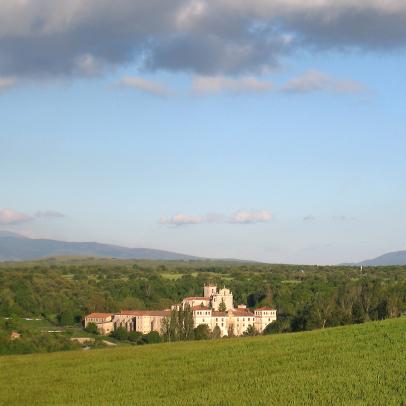The monastery of San Pedro de Cardeña, which was founded by the Benedictine Order in 899 when Burgos was living its medieval glory, is one of the most important monasteries in Castile. During the 19th century, the monastery was plundered several times, especially during the French occupation (Spanish War of Independence) and the Spanish confiscation period.
El Cid is firmly linked with the monastery of San Pedro de Cardeña. The association of El Cid with the monastery became even more intense after his death: due to the increasing impact of the siege on the city of Valencia by the Almoravids, El Cid’s widow, Jimena, left the city on 5th May 1102, taking El Cid’s remains to the monastery of Cardeña. He is believed to have been buried there using an unusually effective embalming and clad in rich vestments. In 1272, 150 years after he had been interred for the first time, the remains of El Cid were removed by Alfonso the Wise, a relative of El Cid. He ordered a sepulcher to be wrought so as to bury the hero and his wife. His remains lied enclosed at the monastery until the War of Independence, during which French soldiers looted the tombs looking for valuable treasures, as a result of which El Cid’s remains were scattered and stolen. This is the reason why there are several museums in Europe that claim to keep the bones of the Castilian knight.
Even though El Cantar states that El Cid left his daughters in the monastery of Cardeña in the abbot’s care, there is little historical evidence to back this piece of information. According to the poem, El Cid, exiled by the king, left Burgos and rode through the night, arriving at daybreak at the monastery of San Pedro de Cardeña, where his wife Jimena and his daughters were staying under the abbot’s protection. El Cid remained at the monastery 5 days until he reunited a party of men that would accompany him in his adventure. He left on the seventh day accompanied by 175 knight men. After the conquest of Valencia, El Cid sends Álvar Fáñez with some 100 on a mission to bring his wife and daughters to their new home.
The monastery is built in the Romanesque style. The “Tower of Doña Jimena” and some parts of the cloister, both of which date back to the 12th century, have survived to the present day. The cloister has semicircular arches resting on short rigid pillars. The bell tower, whose construction began towards the end of the 10th century, is the monastery’s oldest surviving structure. It was originally detached from the church and was later connected to the Gothic monastery by means of a spiral staircase. Legend has it that this was the point at which Doña Jimena bade a sad farewell to her husband, when he went into exile.
The Gothic church was built in the 16th century. One of the lateral naves houses the sepulchers of El Cid and Jimena, where their remains were buried until the War of Independence, during which French soldiers looted the tombs. They were later reinterred in the Cathedral of Burgos.
There are two statues of El Cid on the façades of the monastery and the church: a 17th century statue in attitude by Santiago Matamoros decorates the façade of the monastery and a simple 16th century hieratic statue decorates the façade of the church.
Only a few metres away from the monastery’s tomb, there is a gravestone marking the supposed burial site of Babieca, El Cid’s famous and loyal stallion.
Visits: tickets for guided tours. It is recommended that groups (groups larger than 10 people) book a group visit at 00 34 947 290 033.
Rev. PAB 26.12.18







